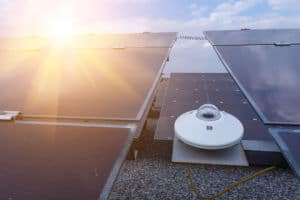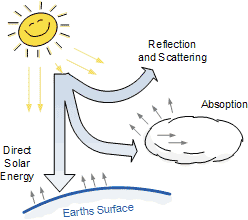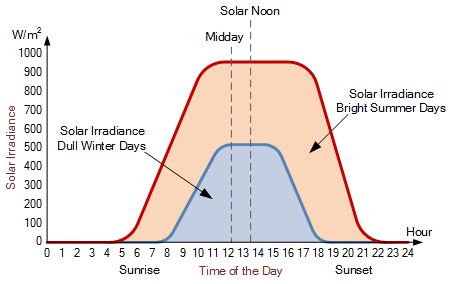Solar Irradiance
What is a Good Solar Irradiance
![]() What is Solar Irradiance, and what does it mean when dealing with solar photovoltaic systems. There are many different words and meanings such as solar radiation (electromagnetic), solar irradiance (for power), solar irradiation (for energy), as well as solar insolation to describe the amount of sunlight that is available at any particular location.
What is Solar Irradiance, and what does it mean when dealing with solar photovoltaic systems. There are many different words and meanings such as solar radiation (electromagnetic), solar irradiance (for power), solar irradiation (for energy), as well as solar insolation to describe the amount of sunlight that is available at any particular location.
We can use the suns energy to generate electricity, by using photovoltaic panels, or use it to heat water with the help of solar thermal panels, so having a good supply of solar radiation at our particular location is important.
But what is the difference between solar energy and solar irradiance. Solar radiation refers to the amount of radiant energy emitted by the sun whereas solar irradiance refers to the amount of solar radiation per unit area.
Our sun is both a heat source and a light source, giving us the warmth and sunlight we need to survive. The sun provides huge amounts of energy every day and we can harness it in so many different ways. But how do we know if there is enough radiant energy for a solar photovoltaic (PV) panel to generate electricity.
How Is Solar Irradiance Measured?

The sun is an excellent source of radiant energy. The amount of solar energy per unit area arriving on a surface at a particular angle is called irradiance which is measured in watts per square metre, W/m2, or kilowatts per square metre, kW/m2 where 1000 watts equals 1.0 kilowatts.
However, the direct distance measured between the Earth and the Sun varies annually thereby causing variations in the amount of solar irradiance energy received during the natural cyclic rotation of the Earth over one full year period.
According to NASA, the average irradiance value measured on the edge of space and outside the Earth’s atmosphere on a flat surface positioned perpendicular to the sun is about 1,370 watts per m2 (that is 1.37 kilowatts). This irradiance value given by NASA is called the Solar Constant and is used to determine the solar values down on the Earth’s surface.
But the values of irradiance measured across the surface of Earth are much lower than the solar constant. The scattering and reflecting of the sunlight when passing through the atmosphere decreases the amount of energy which reaches the Earth’s surface due to the climatic conditions at that point.
Irradiation through the Atmosphere

For example, annual conditions such as the time of year, seasonal and temperature variations, cloudy or overcast conditions, as well as the angle at which the sun’s solar rays strike the ground all influence the amount of solar irradiance available at a particular location.
By the time the sun’s rays pass through our atmosphere and reach the Earths surface at sea level, the maximum solar irradiance across a 1m2 flat surface at ground level is measured. Thus at an equatorial location on a clear day around solar noon, the amount of solar radiation measured is around 1000 watts, that is 1000W/m2 (or 1.0 kW/m2).
When dealing with photovoltaic solar panels purely for the generation of solar power, a solar irradiance light level of 1.0 kW/m2 is known as one “Full Sun”, or commonly “Peak Sun”. The definition of “Peak Sun Hours” (PSH) is therefore the number of hours in time that this full sun solar irradiance light level was received at the panels surface at a measurement of 1.0 kW/m2.
However, when the solar radiation is averaged over the entire 24 hour day and night cycle as well as over a whole year of 365 days, even the best locations receive on average per day only 250–300 W/m2. That’s less than 30% of what arrives at the top of the Earth’s atmosphere.
So there is a lot of what is called “solar attenuation”. That is the loss of solar irradiance as it passes through the atmosphere before it reaches the Earth’s surface with solar attenuation being greater during the darker winter months, as snow reflects sunlight.
We could plot the daily, monthly or even annual amounts of solar irradiance (power) available for any given location giving us a clearer idea of the minimum and maximum levels available for the generation of electrical energy using photovoltaic panels as shown.
Graph of Solar Irradiation During the Day

We can see from our daily example, that the solar irradiance available during the brighter sunnier and longer summer days is greater than that of the shorter, duller winter days as we would expect. So the peak sun hours available during the summer is clearly longer than the winter period allowing a PV panel to operate at its peak rated output longer.
So for example, if the average solar energy which falls on a surface during the summer months is 800 W/m2 and is available for a full 8 hours per day, the daily amount of solar irradiance received during the summer months will be:
Thus from above, we can see that if 1 kWh/m2 is equal to one Peak Sun Hour (PSH), then 6.4 kWh/m2 is equal to 6.4 peak sun hours, or 6.4 PSH.
Now if we assume that during the winter months the average solar energy available drops by half, that is to 400 W/m2 and is only available for half as many hours, that is 4 hours compared to the summer months, then the amount of solar irradiance received during the winter months would be:
Then we can see from this very simple example that the amount of solar energy collected during the sunnier summer months is four times greater at 6.4 kWh/m2, than the solar energy collected during the duller winter months at only 1.6 kWh/m2. Again according to NASA, the worldwide daily average value of solar irradiance across the whole planet over one day is approximately equal to 5.0 kWh/m2 or 5 peak sun hours (PSH).
Solar Irradiance Worked Example
Photovoltaic (PV) panels convert solar irradiance into electricity. If we assume we have a single 200 watt photovoltaic panel, how much energy could be potentially produced by the panel per day during the summer and winter months using the peak sun hours values from our example above.
Solar panel output during the summer days:
Solar panel output during the winter days:
Thus if we assume we need 1000 watts per day of solar energy to power our home, we could do this during the summer months with just one 200 watt photovoltaic panel, but would require four 200W panels during the winter months. Therefore, a higher solar energy availability (by means of PSH) will result in a smaller solar PV wattage requirement, while a lower peak sun hour value, will require a much higher PV wattage.
However this is a very simplistic example, in reality the PV panel requirement to power a particular home or charge a battery bank will ultimately be determined by the connected load and consumption rather than in higher or lower PSH values.
But it gives us a good example of how the solar irradiance and peak sun hours (PSH) at a particular location not only varies based on geographic location and weather throughout the year, but determines the size and cost of any planned solar photovoltaic system.










what is the average solar thermal panel efficiency ?
In terms of efficiency at converting energy from the sun, solar thermal is more efficient in converting solar energy into heat at around 70-80%, while solar PV on the other hand is only around 15-22% efficient. So in theory thermal panels will require less roof space than PV.
The solar irradiance at my place is 6 Kwh/m2/day. I want to convert this value into w/m2 I know to do that i have to divide number of hours ..
But i am confused that I have to divide by 24 h or the time in hours for sun is at the high intensity , i mean day light time
To convert kilo-watts to watts, multiply by 1000. Thus 6kW = 6000 watts. Therefore 6 kWh/m2/day = 6000 Wh/m2/day.
One day is 24 hours, thus 6000/24 = 250 watts/m2 per hour
I am working on a project and I am trying to remove areas on a rooftop that are not suitable for rooftop solar panels based on the amount of solar radiation received. What is the adequate amount of solar radiation receival per year in order to install rooftop panels?
Depends where you live. You can find the amount of solar irradiance in kWh/m2/day received for your area online, at your local library or town hall
This is really useful. I am trying to understand solar for my home and now feel confident understanding the difference between solar irradiation/radiation/insolation etc etc. I really appreciated your clear explanation for calculating the amount of irradiance received during the day to find the potential power it can generate! Also very important to remember that it won’t be consistent throughout the year! Especially in the UK as our sunny days feel far and few between. Thank you!
Wow this was so helpful!!! Thank you 🙂
A great tutorial for me. Thanks to the author, and all the contributors.
Hi there,
If the system is going to be installed at a location with a varied average yearly solar irradiation on the collector surface of 1.2MWh/m (squared) per year, with the thermosiphon collector active area as 35m (squared), what would the average yearly energy obtained from the solar irradiation possible on the collector surface be?
Please help!! I am struggling a lot with finding the energy from this info.
If the yearly solar irradiance on the collector is 1.2MWh for each metre2, then for a surface area of 35m2, the yearly total would be 1.2MWh x 35 = 42MWh, or 42,000kWh, or 42,000,000Wh
hello I’m trying to wrap my head around this so my calculations aren’t wildly off the solar iradiance is all the radiation or electromagnetic energy in that square meter? It’s quite important to my calculations to compensate for many variances thank you
As explained in the tutorial. All the solar energy (insolation) received on the surface of the earth originates from the sun due to solar activity. Since the earth is round, the sun’s rays strike the surface at different angles at different places. Solar irradiance is a measure of the suns intensity or power density over a certain area, commonly defined as being an average intensity of 1kW/m2 or “one full sun” on bright, sunny days. This irradiance value assumes perfect atmospheric conditions and direct beam insolation. Clouds, ambient temperature, shading and incidence angle can and will reduce this value. Equally, solar irradiance can also exceed 1kW/m2 around the hours of solar noon if snow and reflective surfaces are present. Thus, the higher the solar irradiance per unit area, the more solar generated electricity for a particular PV panel can produce.
What is the difference between solar irradiance and radiation. I am not clear on this.
Solar Irradiance is basically the brightness of the sunlight at a given spot on the earth. A photovoltaic’s power and current output is more or less proportional to solar irradiance.
Solar Radiation is the total electromagnetic radiation emitted by the sun towards the earth and is defined between ultraviolet to infrared wavelengths. That is solar radiation is both light and heat which can be used by photovoltaic solar panels to generate electricity, or passive solar thermal panels to produce hot water. The solar radiation at the earth’s surface on a clear day has a power density of approximately 1 kW/m2
Hi, Just curious re the Solar Panel efficentcy Factor , which I beleive may run from 9% to 21% depending on the age and design tech in the solar panel . Not sure that is included in your example with the 200W Solar Panel.
Be very interested in some discussion on this . Solar Panel Conversion efficentcy does seem to create confusion. Many thanks ,
Yes you are correct that panel efficiency without solar concentrators can be less than 20%. A solar panel’s conversion efficiency is the percentage of power converted from the absorbed sunlight into electrical energy when connected to an electrical circuit. So if we assume that a particular panel is 20% efficient, this means then that 80% of the light energy that reaches the surface of the solar panel is not used.
Every solar panel has a nominal rated power output measured in “watts-peak”, (Wp) at full sun (1kW/m2), and in our simple example we assumed the panel to have a peak wattage value of 200 watts. Then the panel will supply 200 watts of power at 20% efficiency when subjected to 1kW/m2 of full sun. So assuming a linear output, if the same panel was 40% efficient it would produce 400 watts (double) at the same light level, or the physical size of the panel could be halved and still produce 200 watts, and so on.
Clearly, a solar panels conversion efficiency depends on many factors such as type of silicon, mono, poly, amorphous, climatic conditions and panel temperature. But the greater the efficiency the higher the rated peak power output, or the smaller the panel size for a given standard rating.
You could try this this calculator
why is solar noon different to midday at 12 for solar irradiance?
Midday is basically 12 o’clock separating the morning from the afternoon. Solar Noon is when the Sun reaches its highest position in the sky during daylight hours